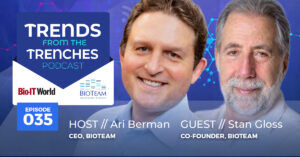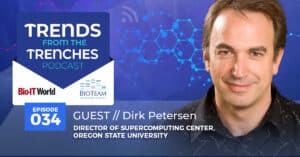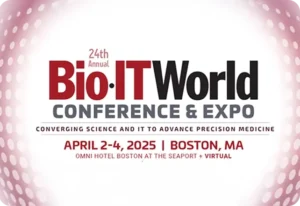Stan Gloss, founding partner at BioTeam, interviewed Krista McKee about the importance of data alignment, accessibility, and how to keep it all moving forward. This article was originally published by Bio-IT World in October 2021.
Krista McKee’s 20-year career in pharma—spanning Genzyme, smaller biotechs, Novartis vaccine development, and the last 7 years at Takeda—has steadily taken her on a trajectory toward data science. She is currently Head of Insights and Analytics at Takeda’s Data Sciences Institute (DSI).
McKee recently sat down with Stan Gloss, founding partner at BioTeam, to discuss how Takeda is recognizing the importance of data alignment and accessibility and the choreography necessary to keep it all moving forward. Bio-IT World was invited to listen in.
Editor’s Note: Trends from the Trenches is a regular column from BioTeam, offering a peek into some of their most interesting case studies. A life science IT consulting firm at the intersection of science, data and technology, BioTeam builds innovative scientific data ecosystems that close the gap between what scientists want to do with data—and what they can do. Learn more at www.bioteam.net.
Stan Gloss: Can you tell me more about the Data Sciences Institute at Takeda?
Krista McKee: Absolutely. The Data Sciences Institute (DSI) is a collection of R&D functions that are focused on data. Some of those functions are the more known ones, like statistics, programming, and epidemiology. Others are less known and focused on things such as data architecture, data flows, digital endpoints and other applications of data and digital. Throughout these functions, we are working to apply data science principles to get medicines to patients faster.
What does your role look like in DSI and what sets it apart?
My group, called data architecture and digital solutions, falls into the lesser-known category. We are a group that enables R&D to interact with data in new ways. We do this by partnering across functions and into IT to deploy strategies around data architecture, data governance and access, data harmonization and enrichment, and data insights. When you think about that across R&D, the remit is quite broad. In the last five years, we’ve gone from showing what’s possible through specific use cases, to now starting to lead in establishing a data ecosystem that is going to be scalable for R&D and get our data ready for AI. We’re also working to enable an analyst and data science community throughout R&D who can readily access the right data.
Can you tell me more about the different data types and how DSI is prioritizing the exposure and organization of them?
When you think about R&D data, there’s operations data, there’s financial data, there’s clinical trial data, there’s research data, just to name a few. We have demonstrated that you get a lot of value if you can start to bring in and organize certain types of data for both learning and use in day-to-day decision making. And applying automation to make it easier to interact with data across the ecosystem is important.
How did your prior experience bring you into this role?
From biotech R&D, the vaccine development machine at Novartis, a leadership role in Takeda’s oncology therapeutic area unit and especially seeing the accountability necessary in the clinical trial delivery world, I learned about the trade-offs and interdependencies of data management. And despite how complex and hard all this is, it could be much easier if we take better care of our data as an asset and manage it accordingly.
Once the DSI was created within Takeda, I quickly found myself just gravitating toward it and finally partnered with my current boss on a project called Platypus, a Bio-IT World award winner in 2018, where we effectively knocked down silos around the clinical data with the right controls and governance to give the right people modern access to do what Takeda needed to do from an oversight perspective in our trials.
We love knocking down silos. Did that project create momentum?
That success led to another project where we automated the aggregation of data within programs for more proactive safety signal management. This project is one I am most proud of because of its direct benefit to patients. It also led to a project where we’re bringing the clinical data that we’ve harmonized on the cloud together with organized pre-clinical data to enable reverse translational insights. We’ve also supported efforts on operational data to give insights much more quickly and broadly than before.
Can you talk about the culture around this transformation?
At a large organization like Takeda, the old way was always hard; people owned data and thought of that data only in the context of their own use. The owners of a certain type of data never really appreciated that other people also needed these same data to effectively do their jobs.
Through our work, we are consistently showing people that we can use modern technology to organize and expose data—with the right controls of course. Sitting as a business function close to the core of R&D, we understand governance is a big part of what we do and we’re working to deploy an efficient governance less focused on “Why do you need it?” and more on “Why can’t you have it?” That’s been a huge challenge all along, but it’s something we’ve created a framework around and are continuing to refine.
Aligned with this, we are starting to communicate three levels of data. Level one is raw or novel data. We need to make sure we have all this data coming into our cloud-based ecosystem. Level two, or aligned data, is the data we harmonize or enrich and organize into accessible data models. And level three, consumed data, refers to democratized use of data to inform the many facets of R&D. Our overall objective is to appropriately and efficiently allow insights from anywhere across R&D. And our hope is that on Day 1 at Takeda, any R&D analyst or data scientist can have an appropriately comprehensive and transparent view of all three levels of data.
So, would I be correct to hear you say that the culture around this is really shifting?
Yes, we’re starting to shift and show the value of that deeper organization. In most meetings I attend right now, I refer to the three levels of data, and people get it. They understand the value in taking the time to get data ready so that those insights can be achieved.
Is this value mostly understood in the context of ML/AI?
When we talk about AI/ML, there’s a lot of potential value there, but most of it is still very unrealized in the R&D space. There is a need for iterating and a lot of potential vendors with which to partner. We need to have an ecosystem where the lift to engage someone with our data isn’t going to be so big every time.
Additionally, the questions that certain data types can answer are much broader than the discipline in which the data types themselves sit. When you think about machine learning algorithms, you need a lot of data. So making sure data scientists working on operational prediction algorithms, for instance, have access to the many types of data that could meaningfully inform their algorithms is important.
Can you take me through a little of the journey that you took to transform just that little piece, moving away from “my data” and breaking down silos?
The brilliance of DSI at its inception was that we were a unique group in the organization that was bigger than any one particular functional allegiance. We were declared to serve Takeda R&D and were able to operate from the perspective that all data is Takeda’s data. And anyone within R&D could come to us and have a listening ear. If someone had a data need, they had a place to go and a group that was both incentivized and had the means to help them.
It’s all about aligning people, technology, and processes. Other companies have data science centers of excellence and specific platforms, they talk about a data fabric. Does Takeda have a platform that all these data are fed into and everybody can access?
What we have centers around AWS, the data lake approach, and mechanisms to enable consumption of data of various types such as data marts or APIs. Until recently, my group has been more focused on directly delivering insights based off our cloud-based data layers. Now we are pivoting to focus more completely on maturing the data foundation and governance so that insights can come from anywhere.
Are there specific rules about which data are fed into this platform and how they are structured?
We are advanced in our culture and what we have in the cloud-based environment today. We have a mandate across R&D that says all R&D data goes into our cloud-based ecosystem and are deploying tools to expose what’s there and the teams to appropriately govern what’s there. We are also working to ensure that these data can be readily accessible in modern data exploration and data science platforms in which Takeda has invested.
The amount of investment in time for structuring and aligning data can’t be underestimated. How much of your data would you characterize as FAIR compliant?
That’s a good question. I don’t know that I could give a number that I could hang my hat on. When we say all R&D data goes into this ecosystem, there’s just so much. So much remains untapped even with the good progress we’ve made. As I’ve talked to my counterparts in various companies, one thing that is noteworthy for Takeda is that even as we’re doing the heavy lifting to get that organization of the data, we’re doing it in the context of delivering the value along the way. That said, we still have a ton of work to do.
What are the biggest challenges that you face now in continuing the evolution of your digital transformation?
The art of bringing together people, process, and technology in a meaningful and enduring way that continues to improve over time is a challenge. There’s certainly a sprint aspect to it and a marathon aspect to it and finding that balance of getting the right initiatives defined with the right cross-functional attention and ownership that is enduring, it just takes a lot of effort.
Another challenge is in effectively deploying efforts across a large organization to get things moving. Many people’s day-to-day jobs don’t change, but functional experts need to find a space to be part of these initiatives and to really re-engineer how they are working every day. People are willing but there’s a lot of choreographing, and I like to think of myself very much as a choreographer, bringing all these pieces together and having the early wins and the excitement maintained over time to get that long-term value for the organization.
Beautiful. What advice would you give organizations that are significantly behind you in terms of evolution?
What’s been really critical and what I’ve valued a lot at Takeda has been the boldness of its leaders. In the beginning of my time at Takeda, that boldness was most noticeably a communicated one. Messages like, “If you see a problem, feel empowered to find a way to fix it,” resonated with me in my earlier days. Over time, the leadership messaging has been bolstered by bold action—which is critical to Takeda’s success. Data and digital imperatives are now commonplace at Takeda. There’s space for that innovation but also acceptance that it is an iterative process which will include failures from which we will need to pivot. There is also a culture that notices and rewards progress. There is something about people coming together to really drive forward innovation and progress that of all the places I have been, it’s unique and it’s why I love working for Takeda.


